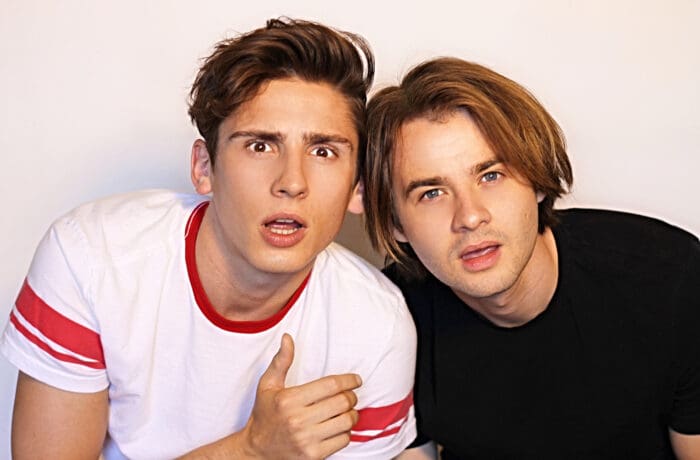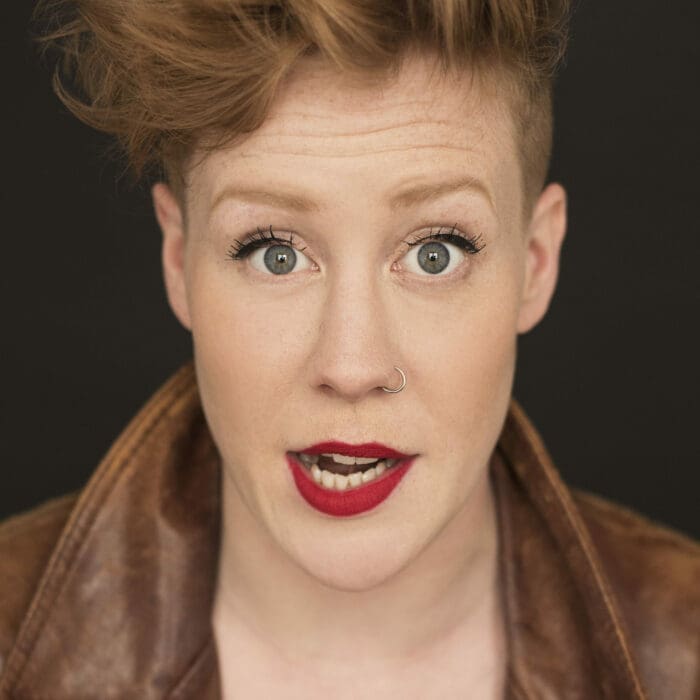Before we announce the winners of the 2019 MyEntWorld Critics’ Pick Awards, we’re proud to present our annual Nominee Interview Series.
Fiona Sauder’s Outstanding Direction-nominated work on Bad Hats Productions’ remount/expansion of Life in a Box was one of the fun and inventive highlights of our year in Toronto theatre. The original Fringe production was nominated for performance and new work last year and Fiona’s thoughtful eye and sense of adventure was exactly what the show needed to make it soar even higher.
Catch us up on life since your last Nominee Interview Series in 2017.
Well, goodness. There have been several lifetimes lived since 2017. Let’s see. Since we last chatted, I’ve:
-written a bunch of drafts of plays I believe in
-bought a lot of second hand clothing in Niagara on the Lake
-seen a lot of theatre / live music
-picked back up the saxophone
-put back down the saxophone
-learned to play the venova
-explained what a venova is to a lot of people
-been to New Orleans
-watched my best friend have three brain surgeries
-peed my pants more than four times
-played Peter Pan five times
-drank some whisky
-watched my theatre company be named Soulpepper’s first Associate Company
-murdered two computers
-regretted a mattress I bought
-been in a play at Soulpepper that wasn’t Peter Pan
-driven all the way to my cottage with the parking brake on
-worn a lot of stripes
-been in a YPT premiere
-learned about steel cut oats
-made a lot of buttons
-given some tattoos
-cut a lot of people’s hair
-directed a mega musical in Sudbury
and
-eaten 1000 meals cooked to perfection by Paolo Santalucia
Your company Bad Hats Theatre produced the remount/expansion of Life in a Box. What was it about the original show that made you want to invest in its next chapter?
This show is so unique. The story is shaped within such an uncommon and exciting container that requires incredible physical and narrative dexterity from the performers and the result is so captivating. You can’t help but be drawn in and delighted. When I saw the original production at Fringe it felt like watching something both timeless and singular, and something Bad Hats absolutely had to be part of. The second I turned my phone back on after the show I texted both the boys and said, essentially, ‘how can I help this project? I want in.’
How did you get involved as director?
Sometime in 2018 the Bad Hats team went over to Landon [Doak] and Matt [Finlan]’s apartment for a meeting about the project. Walking over from my own apartment, we chatted about ways to convince the boys to work with us, meanwhile, at their place, they’d been refining their pitch on getting Bad Hats involved. Very early in the meeting the mutual interest became clear, and we laughed when we realized that we had all shown up with the intention to pitch one another. Somewhere within that they expressed their hope for me to direct, which had also been my wish, so it was quite simple and kismet.

Tell us about working with Landon Doak and Matthew Finlan as both creators and performers.
Matt and Landon are ridiculously hard workers who are hellbent on having a good goddamn time. It’s total play at a very fast pace. Collaborating with them has bred both some of the most efficient and most joyful work of my career. They’re also incredibly smart, and they challenge me creatively in a way that I love. I honestly smile just thinking about being in the room with them. If anyone wants low maintenance, life-giving lighting in a bottle – they should hire Matthew Finlan, or Landon Doak, or both for their next project. They are an utter delight.
How much of Rebecca Ballarin’s original direction did you use as a jumping off point for the first two episodes, or did you start completely from scratch?
We certainly didn’t begin again when looking at reworking the piece, many of Rebecca’s original offerings remain in the fabric of the show, because so many of them worked. That said, this process included many new elements for the piece including fresh dramaturgy, pre-recorded music, a jungle gym of a set, and a brand new third episode. So, there was plenty that needed to be adjusted, invented and reinvented. The main facets of the staging would be familiar to anyone who saw the fringe production – the visual frame of the piece, the movement style, the minimalism etc. but the blocking and scope have all been adjusted to a more heightened vision. Much of what exists in the world of Life In a Box comes from Matt and Landon themselves and directing the show, for me, often just meant pointing their energies and abilities in the right direction.
The show is about time travel so you’re dealing with jumps in time and space and different iterations of the characters- how did you approach keeping everything straight and clear for the audience?
The script does a lot of this work itself. Matt really thinks of everything, so when something new evolves in the narrative, it’s usually spelled out for the audience. The writing style is contemporary bordering on cartoon, which allows a little more room for beating us over the head with the science of what’s going on. That said, the science of it all isn’t really the main focus. Science is more of a cousin to the piece – still invited to dinner but doesn’t live in the house.
Your direction was really physical, almost acrobatic. How did that visual language develop and was it tricky to rehearse to get the level of precision necessary to pull it off?
Once we had the box itself built (a sort of metal cage hidden behind a scrim) we just started messing around and seeing what shapes and movements were possible. Once we’d built a rolodex of gestures, we started fitting them in where they made the most sense. Whatever made us laugh or gasp would stay. Of course, there were lots of changes as we discovered more possibilities throughout the process and the boys became more comfortable on the set. I remember sometime in the bowels of tech the day before opening, Matt was messing around on the monkey bars of the set and he did this thing where he swung back and forth with his legs crossed. He asked, ‘Does this look cool?’ (perhaps the most used phrase in the Life In A Box rehearsal hall) and yes, it did look cool, so we swapped that move in for another, even though it was physically far more strenuous. The boys really wanted to do it. This kind of thing happened a lot as we built the blocking. Achieving the precision and synchronicity just took a lot of repetition and detail work.
Did you have a favourite moment in the production?
The twist at the end of episode three is pretty spectacular, and sets us up for a pretty exciting (and challenging) episode four. Stay tuned for that. I’m also pretty partial to all the moments in the piece when the boys express genuine love and care for one another. I seldom see this kind of relationship between men onstage presented without comment or irony.
You just finished your latest run in Peter Pan with Soulpepper. How has the experience of that piece and that role evolved for you over time?
Peter Pan has been an incredible ride. Every iteration (seven of them in five years, holy cow) has had its own unique joys and challenges. It’s a total gift to be able to return to a show this many times, especially one so rooted in joy and play. It’s also incredible to work with a company of creators who are so keen to continue improving the work. Every year new elements emerge. I’ve had the pleasure of, ironically, growing up over the course of the productions, but they also act as a reminder of what hasn’t changed and what ought never to change for me as an artist. The show is an expression of many lessons I hold dear and was created in the spirit with which I hope to approach all my work. Each visit to Neverland has been an excellent barometer for myself, and the company as a whole.
Has a child who’s seen Peter Pan ever recognized you out and about in the city? How do you deal with those encounters, do you play along in character or introduce yourself as Fiona?
The other day a woman with a gaggle of children stopped across the street from me and said ‘Look! Who’s that?’ and the children all shouted, ‘Peter Pan!’ Following that, I, naturally, crumbled into a million pieces.
I’m really grateful to say I often have moments when children recognize me from the show. It can be quite magical. They seem to understand pretty quickly that I’m the actor who played Peter Pan and not Peter Pan in the flesh, but they usually need a little time to size me up and decide whether that’s a cool thing or not. I try to read the mood and make sure to spend a little time with them if they’re into it. Then I usually have to get out of the situation because I’m too moved to contain myself.
What are you working on now/next?
I recently wrapped up a workshop for a new piece I’m writing at Bad Hats called Princess Frownsalot which is being presented by Roseneath Theatre this April. The show is for children 5+ and promotes honest dialogue surrounding mental health. While that tour is afoot, I’ll have the good fortune of acting in the premiere of Susanna Fournier’s double bill Always Still The Dawn at Canadian Stage. Bad Hats is also in the midst of developing a new musical adaptation of Alice In Wonderland, for which I’m writing the Book and Landon Doak and Victor Pokinko are Co-Composing. Stay tuned for more on that soon!
Do you have anything you’d like to add?
Thank you for taking the time to administrate all of this. You’re awesome.

